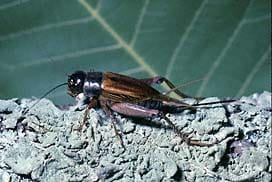Source(s): Jacob G Price
Crickets belong to the insect order Orthoptera, which also includes grasshoppers and katydids.

Description
House Cricket – About 3/4″ long with 3 dark bands on the head and long thin antennae. Body is yellowish-brown. Active at night; remaining hidden during the day. Eats and drinks almost anything that is available. Enters homes during July – September.
Field Cricket – Larger than the house cricket. Dark brown to gray or blackish in color. Feeds on soil and other material. Prefers to live outdoors where they feed on soft plant parts, but moves indoors when conditions are unfavorable (excess heat, cold or rainfall). Attracted to lighted areas at night.
Camel Cricket – An occasional indoor pest. Usually found in damp and dark basements which have a partial dirt floor.
Detection
Visual sighting. House cricket will chew and damage silk, woolens, (particularly if soiled), paper, fruit and vegetables.
Control
- Remove feeding and breeding (debris and high grass) sites outdoors.
- Exclusion: tighten screens, windows and doors, seal openings near ground level. Caulk cracks and other points of entry.
- Apply an insecticide containing one of the active chemicals: cyfluthrin, cypermethrin, deltamethrin, orthoboric acid, permethrin, propetamphos, tetramethrin, or tralomethrin. Read the manufacturer’s label to determine if product may be used outdoors only or both indoors and outdoors. Follow manufacturer’s use instructions. Look for these products at garden centers and feed and seed stores.
- Use sticky-traps in attics, basements and other indoor spaces.
Center Publication Number: 17
- Growing Asparagus: A Luxury Vegetable - September 24, 2013
- Frizzle Top in Sago Palms - September 24, 2013
- Growing Onions in the Home Garden - September 24, 2013